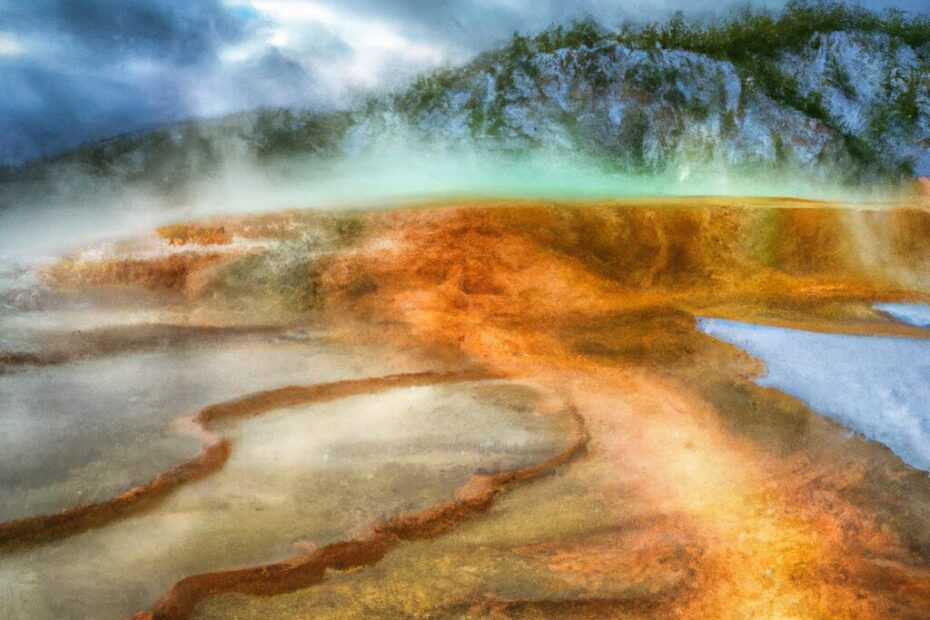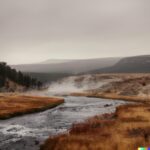Yellowstone National Park is home to some of the world’s most famous geysers, but these natural wonders have a significant environmental impact. From changes in water quality to effects on plant and animal life, the geysers play a crucial role in the park’s ecosystem.
Human activities, such as geothermal energy extraction and tourism, also have an impact on these geothermal features. In response, efforts are being made to monitor, regulate, and educate the public about the importance of protecting Yellowstone’s geysers. In this article, we will explore the environmental impact of Yellowstone geysers and the measures being taken to preserve them.
What Are Yellowstone Geysers?
Yellowstone geysers are natural hydrothermal features found in the Yellowstone National Park, known for their spectacular displays of erupting hot water and steam.
These geysers are formed by underground water being heated by the Yellowstone Caldera, resulting in periodic eruptions of boiling water and steam. The unique combination of heat, pressure, and geological formations creates the conditions for these remarkable features.
The park’s geysers not only provide mesmerizing spectacles for visitors but also serve as critical components of the park’s hydrothermal activity, playing a key role in the ongoing geological processes and contributing to the overall ecosystem health within Yellowstone.
How Do Yellowstone Geysers Form?
The formation of Yellowstone geysers is attributed to complex geologic processes involving the interaction of magma, groundwater, and specific geological formations within the park.
The geysers in Yellowstone owe their existence to the unique geological features of the area. The park is situated on top of a supervolcano, and the heat generated from this volcanic activity is a crucial factor in the geothermal processes.
Additionally, the presence of geothermal mineral deposits, such as silica, helps create mineralized conduits that allow for geyser eruptions. This interplay between volcanic activity and mineral-rich water results in the breathtaking geysers that attract visitors from all corners of the globe.
What Is The Environmental Impact Of Yellowstone Geysers?
The environmental impact of Yellowstone geysers extends across the park’s ecosystem, influencing water quality, plant life, wildlife, and soil chemistry.
This impact on water quality is evident in the high mineral content found in geyser water, affecting the overall balance of the park’s aquatic systems.
As for plant life, geothermal features create unique habitats for thermophilic flora, contributing to the park’s biodiversity.
Wildlife is both directly and indirectly impacted, with certain species thriving in the geothermal areas, while others may experience habitat displacement.
The influence on soil chemistry alters nutrient levels and microbial communities, shaping the landscape and affecting ecological processes.
Changes in Water Quality
The discharge of geothermal water from Yellowstone geysers can lead to significant changes in water quality due to the presence of geothermal minerals and microbial communities.
This can significantly alter the chemical composition of the water, affecting its pH, temperature, and nutrient levels. The geothermal systems also introduce unique elements such as sulfur, arsenic, and mercury into the water, posing potential risks to aquatic life and human health.
The microbial communities in these hot springs can influence water quality through processes like mineral precipitation and decomposition of organic matter, contributing to the overall ecological impact of geothermal activity on aquatic ecosystems. These factors highlight the importance of monitoring and managing the environmental consequences of geysers and geothermal systems.
Effects on Plant Life
The thermal features of Yellowstone geysers can affect plant life, leading to ecological disturbance in certain areas due to the unique environmental conditions created by the hydrothermal activity.
The extreme temperatures and chemical compositions of geothermal waters released by geysers can alter the soil composition and structure, impacting the growth and sustainability of plant communities.
The deposition of minerals and sediments from geysers can influence the nutrient availability and pH levels in the surrounding soil, further shaping the plant species that can thrive in these areas.
Ecosystem management in geothermal regions needs to consider the intricate relationship between hydrothermal activity and vegetation to ensure the preservation and restoration of diverse plant life.
Impact on Wildlife
The presence of Yellowstone geysers can have both positive and negative effects on wildlife, contributing to the ecological balance while also posing challenges due to the disturbance of natural habitats.
The geothermal features, including geysers, in Yellowstone National Park provide essential sources of nutrients and thermal habitats that support diverse wildlife species. Many animals rely on the warm waters and unique geological formations for feeding and breeding.
The fluctuating behavior of geysers can sometimes disrupt the surrounding ecosystems, affecting the distribution and behavior of wildlife. Park authorities are tasked with managing these impacts through careful conservation efforts and wildlife management strategies to ensure the long-term well-being of the park’s fauna.
Influence on Soil Chemistry
Yellowstone geysers exert an influence on soil chemistry through the release of geothermal fluids, leading to distinct geothermal impacts on the park’s soil composition and nutrient cycling.
Geothermal fluids found in Yellowstone National Park contain a variety of minerals and chemicals that can impact the soil’s pH levels, nutrient availability, and microbial populations. These factors, in turn, affect the growth and distribution of vegetation within the park.
The unique chemical composition of geothermal fluids also plays a role in the formation of specific soil profiles, creating habitats that are suitable for specialized flora and fauna. It is essential to understand these geothermal impacts to implement effective conservation strategies and maintain the delicate balance within Yellowstone’s ecosystem.
What Are The Human Activities That Affect Yellowstone Geysers?
Several human activities, including geothermal energy extraction and tourism development, have the potential to affect the delicate balance of Yellowstone geysers and their surrounding ecosystem.
These activities can disrupt the natural flow and temperature of geysers, leading to alterations in their behavior and possibly reducing their future sustainability.
Waste disposal from tourist facilities and infrastructure may introduce harmful pollutants into the environment, creating further challenges for the delicate ecosystem surrounding the geysers.
It is crucial for stakeholders to prioritize sustainable practices and environmental stewardship to ensure the long-term health and preservation of these unique geothermal features.
Geothermal Energy Extraction
The extraction of geothermal energy near Yellowstone geysers can have significant environmental impacts, affecting the park’s hydrothermal systems and geological integrity.
This form of energy extraction can lead to the depletion of geothermal reservoirs, altering the delicate balance of underground water and steam. Consequently, the iconic geysers and hot springs in the area may experience reduced activity or even complete shutdowns.
The drilling and injection processes associated with geothermal energy production may induce seismic activity, potentially compromising the geological stability of the region. The disruption of ecosystems and wildlife habitats due to infrastructure development and noise pollution further highlights the need for sustainable geothermal practices and comprehensive environmental conservation efforts.
Tourism and Development
Tourism and development activities in the vicinity of Yellowstone geysers can impact the park’s conservation efforts, influencing the delicate balance of ecological patterns and natural resources.
These activities can lead to increased foot traffic, impacting the fragile flora and fauna in the area. Such disturbances can disrupt the natural habitat and alter the behavior of the geysers.
The rise in infrastructure to support tourism, such as roads and buildings, can further encroach on the natural landscape, leading to habitat fragmentation. It is crucial to promote sustainable tourism practices and implement strict regulations to protect the geysers and their surrounding environment.
Waste Disposal
Proper waste disposal practices are essential to ensure ecological restoration and environmental resilience in the areas surrounding Yellowstone geysers, minimizing potential ecological disturbance and environmental degradation.
By effectively managing waste disposal, the park can reduce the risk of soil and water contamination. This is vital for the preservation of the unique ecosystems around the geysers.
Implementing sustainable waste disposal methods not only fosters a healthy environment, but also supports the park’s commitment to environmental preservation and conservation. By promoting responsible waste management, the park can set an example for visitors and neighboring communities, encouraging them to prioritize sustainable practices for the long-term well-being of Yellowstone National Park.
What Are The Efforts To Protect Yellowstone Geysers?
Various efforts are in place to protect Yellowstone geysers, including extensive monitoring and research initiatives, as well as conservation strategies aimed at preserving the park’s unique ecological diversity and geological impacts.
Protective measures for geysers involve close monitoring to detect any irregularities or potential threats.
Research initiatives aim to understand the geological processes that create geysers and aid in their conservation.
Conservation strategies also include minimizing human impact on these delicate ecosystems, preserving them for future generations to marvel at and study.
Efforts to preserve the park emphasize safeguarding natural wonders and restoring any ecological damage caused by human activities.
Monitoring and Research
Continuous monitoring and research activities play a crucial role in conducting comprehensive environmental assessments and understanding the ecological impacts of Yellowstone geysers, aiding in the formulation of effective conservation strategies.
By consistently observing the behaviors of geysers, researchers can gather valuable data to assess changes in geothermal systems, water quality, and wildlife habitats. This data forms the foundation for developing conservation strategies that aim to protect the unique ecosystems of the park and mitigate human-induced impacts.
Ongoing research efforts contribute to the scientific understanding of geothermal processes, enabling informed decision-making for the sustainable management of Yellowstone’s natural resources.
Regulations and Restrictions
Stringent regulations and restrictions are implemented to manage geothermal exploration and maintain ecological balance around Yellowstone geysers, ensuring environmental compliance and sustainable geothermal development.
These regulations play a critical role in safeguarding the delicate ecosystem surrounding the geysers, helping to preserve the unique biodiversity and natural beauty of the park.
By establishing clear guidelines for geothermal activity, the park can effectively mitigate the potential impact on wildlife and the environment while promoting sustainable practices. This proactive approach contributes to the long-term sustainability of geothermal resources within the park, aligning with the broader commitment to environmental conservation and responsible land stewardship.
Education and Awareness
Educational initiatives and awareness programs are instrumental in promoting environmental stewardship and fostering a deep understanding of the ecological significance of Yellowstone geysers. These initiatives engage visitors and local communities in park conservation efforts, providing valuable opportunities for individuals to actively participate in conservation and contribute to the sustainable management of natural resources.
By enhancing public knowledge about the delicate balance of ecological systems and the impacts of human activities, education and awareness pave the way for responsible visitor behavior and community engagement. This, in turn, helps to protect and preserve the unique ecosystem of Yellowstone National Park.
Through these efforts, Yellowstone National Park can continue to thrive as a living laboratory for environmental management and conservation studies. By inspiring a sense of ownership and stewardship among its diverse stakeholders, the park can ensure its long-term sustainability and serve as a model for other protected areas around the world.
Frequently Asked Questions
What is the environmental impact of Yellowstone geysers?
Yellowstone geysers can have both positive and negative environmental impacts. On one hand, they provide important habitats for unique microbial communities. However, the increased geothermal activity can also disrupt local ecosystems and alter water chemistry.
How do Yellowstone geysers affect the surrounding vegetation?
The high temperatures and mineral content of geyser water can significantly impact plant growth and diversity in the surrounding area. Some plants may thrive in these conditions, while others may struggle to survive.
Do Yellowstone geysers contribute to air pollution?
Yes, the sulfur emissions from geysers can contribute to air pollution in the surrounding area. This can have negative effects on both human and animal health.
What measures are being taken to minimize the environmental impact of Yellowstone geysers?
The National Park Service closely monitors geyser activity and takes steps to protect sensitive areas. Visitors are also encouraged to stay on designated trails and avoid damaging fragile ecosystems.
Can the environmental impact of Yellowstone geysers be reversed?
Some impacts, such as changes in water chemistry, may be reversible over time if the geysers become less active. However, other impacts, like altered vegetation, may be more difficult to reverse.
Are there any ongoing studies on the environmental impact of Yellowstone geysers?
Yes, there are several ongoing studies and research projects examining the effects of geyser activity on the surrounding environment. This research helps inform management decisions and conservation efforts in the park.
Last Updated on January 25, 2024 by Jon Waraas – Originally Posted: January 25, 2024

I’m Jon Waraas, and I’ve been navigating the online world since 2006. By day, I’m the proud owner of some eCommerce gems, and by night, I’m the voice behind the adventures on Waraas.Com.
My heart, however, belongs to the wild beauty of Yellowstone National Park. I’ve got a collection of websites dedicated to sharing the wonders of this natural masterpiece. Oh, and did I mention? I’m currently building my own cabin inside the ghost town of Gilmore, Idaho – a cabin with tales to tell!
When I’m not immersed in the digital realm, you’ll find me lacing up my boots for a good hike or setting up camp under the star-studded sky.




